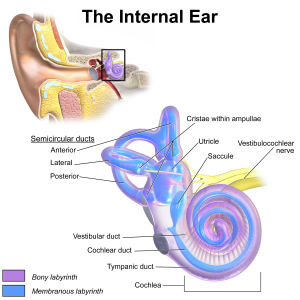
The vestibular system includes the parts of the inner ear and brain that help control balance and eye movements.
Maintaining balance depends on information received by the brain from these three sources: eyes, muscles and joints, and the inner ear. The eyes tell you what you are adjusting to in the environment, the body provides information on where you are in space, and the inner ear tells you how you are moving. In response, feedback messages are sent to the eyes to help maintain steady vision and to the muscles to help maintain posture and balance. When there is a vestibular dysfunction, the person often presents with dizziness, clumsiness, and can even have “nystagmus” or uncontrolled movement of the eyes. Due to a lack of ability to control eye movements, depth perception and visual tracking are often impaired.
The structures of the inner ear are what processes the movements of our heads. The utricle is responsible for picking up linear accelerations and head-tilts in the horizontal plane (ie: riding a bike) . The saccule is responsible for detecting linear accelerations and head tilts in the vertical plane (ie: jumping up and down). The semicircular canals detect rotational and angular movements and acceleration of the head while moving at an angle (bringing one ear to the ground).
angular movements and acceleration of the head while moving at an angle (bringing one ear to the ground).
Mechanisms for recovery from vestibular related functional impairments are habituation, adaptation, substitution, and motor learning. If the loss of vestibular function occurred at or shortly after birth, the impairments will effect the child’s use of vision and input from the body for balance, thus making this the focus of treatment. Techniques for treatment should include facilitation and improvement of visual stabilization, movement tolerance and balancing during visual stabilization, and balance training under varying environments.
“Children with vestibular disorders often respond well to a specialized form of therapy called vestibular rehabilitation therapy (VRT). VRT is an exercise program tailored to address eye-movement control, dynamic visual acuity, balance, developmental reflexes, and body-movement functions. Exercises should be based on a child’s age, interests, and level of comprehension. For example, appropriate balance or eye-movement exercises for a child aged 4 may involve block designs or balancing on a therapy ball. For a child aged 7, the same goal may be accomplished with a visual maze or balance obstacle course.” https://www.vestibular.org/
Activities that strengthen the vestibular system:
- swinging in a swing or hammock
- climbing trees and playground equipment for hanging, climbing, and sliding
- yoga
- biking
- swimming
- obstacle courses
- jumping on a trampoline
- somersaults and cartwheels
- balancing on a curb or balance beam
- basketball
- horseback riding
- hanging upside down on the back of the couch
- rollerskating and ice skating
Kids needs LOTS of movement and not just running.

*Quote from Angela Hanscom OTR/L
